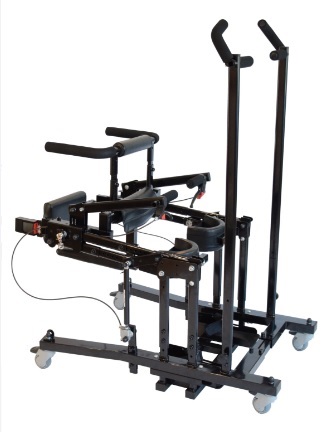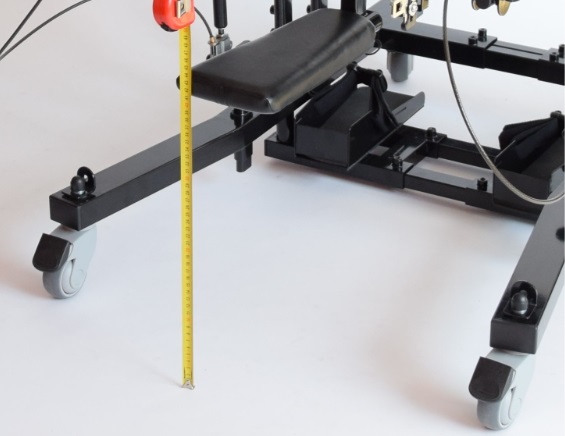ErgoStander static standing frame
Static standing frame ErgoStander with patient lifting function is a modern verticalization device for people with serious musculoskeletal dysfunctions (paraplegia, quadriplegia). The standing frame enables the user to stand upright on his own and perform exercises in the form of squats and half-squats, thus counteracting negative effects of long-term sitting and lying. The ErgoStander verticalization device is an excellent rehabilitation tool used both in hospitals and rehabilitation centers, and above all at home.

Static standing frame ErgoStander is equipped with a special chassis system and a stabilization system for the lower and upper body parts that ensure the patient’s safety in a standing position:
– The patient’s feet rest on special platforms and are secured with straps that prevent the feet from accidentally slipping out of the platforms while lifting and standing.
– The patient’s shanks are supported on special supports slightly below the kneecap and secured with straps that prevent the lower legs from accidentally slipping out of the supports while standing.
– The patient’s pelvis is secured with a special corset that opens at the back and is closed with the certified snap lock.
– In the event of loss of patient’s consciousness or torso leaning in any direction, it is not possible to cross the tipping edge of the standing frame ( it is impossible for the patient to fall over in the device). The standing frame remains statically and dynamically stable throughout its use.
– For patients with quadriplegia who are unable to independently hold their torso in a straight position, a special chest support, the so-called trunk stabilizer has been designed.
The ErgoStander static standing frame is equipped with a pneumatic lifting mechanism, activated by two levers located on the handles near the thumb of the disabled person’s hand. This solution means that little force is needed to move a patient with high body weight and severe disability from a sitting position in a wheelchair or lying on a bed to a standing position, and the verticalization process is very safe and comfortable for both the patient and the caregiver.
Undoubted advantage of the standing frame ErgoStander is the ease of moving patients into it. Movement from a sitting position on a wheelchair or bed takes place horizontally and requires minimal force. The seat height can be easily adjusted to the level of a wheelchair or the surface of a bed. The standing frame seat can be lowered to approximately 41 cm above the floor. This solution is very convenient both for the patient and the people participating in his rehabilitation.


Who is the ErgoStander standing frame intended for?
The standing frame ErgoStander is intended for people who have lost the ability to move independently in an upright position as a result of:
– spinal cord injury,
– cranial trauma,
– stroke,
– sense of balance disorders,
– neurological diseases,
– significant loss of muscle strength caused by diseases of old age,
– prolonged lying down due to illness, surgery and fractures.
It is possible to adapt the device to the individual needs of the patient and/or caregiver.
Each ErgoStander standing frame is individually adjusted to the patient’s body parameters, such as height, weight, length of lower limbs, width and depth of the pelvis. The standard equipment of each ErgoStander model includes a torso stabilizer and levers for standing up independently. Optional equipment includes gloves, which are necessary in the case of quadriplegia. Gloves are used to fasten patient’s hands on levers that enable him to stand up and sit down independently.
Verticalization in the static standing frame ErgoStander
In order to eliminate the negative effects of long-term stay in a lying or sitting position, people with physical disabilities should be placed in an upright position for at least 2-3 hours a day.
From the point of view of a patient and caregiver the ideal device for daily verticalization of a disabled person at home should have the following functional advantages:
– Using the device should be completely safe for both the patient and the caregiver. Upright positioning should be easy to perform and not require much effort from the patient and caregiver.
– All phases of the upright positioning process should be understood by the patient and caregiver.
– All phases of verticalization should be under full control, so that the verticalization process can be interrupted at any time, return to the initial state and repeat all activities.
The ErgoStander standing frame meets these criteria!
Phases of verticalization in the static standing frame ErgoStander:
Verticalization in the ErgoStander device can be divided into two basic stages: Moving the patient from a sitting position on a wheelchair/bed to a sitting position on the seat of a standing frame and lifting the patient.
I) Moving the patient from a sitting position on a wheelchair/bed to a sitting position on the seat of a standing frame.
– If the patient is sitting in a wheelchair place the standing frame seat flush with the wheelchair seat or below the wheelchair seat (then the standing frame seat can slide under the wheelchair).
– Open the back of the corset and move the wheelchair into the standing frame.
– Place the feet on platforms and secure them with belts.
– Grab the arm supports and move the body horizontally onto the wheelchair seat. If the caregiver’s help is needed, he or she grabs the patient’s lower legs and slightly pulling the patient’s body towards him, moves the patient’s body to the seat of the standing frame.
– Place the lower legs in the supports and secure them with belts.
– Close the back of the corset. The patient is ready for verticalization!
II) Lifting the patient
– Press the lever to unlock the gas springs
– If the patient wants to get up on his own (even a quadriplegic can do it), he grabs the lever handles of the standing frame with his hands, or in the case of upper limb paralysis, he hooks his hands in special gloves for quadriplegics. Then he slightly lifts his body up. In a properly balanced standing frame, the patient’s body should stop in any position while lifting, and should not fall down on its own under the patient’s weight.
Benefits of verticalization:
– activation of the muscular system,
– stimulation of the circulatory and respiratory system,
– prevention of lower respiratory tract infections,
– preventing swelling of the lower limbs,
– prevention of thromboembolic complications,
– prevention of joint contractures,
– preventing muscle atrophy,
– preventing osteoporosis and fractures
– improving general fitness.
Exercises in the ErgoStander device
People in wheelchairs have to struggle with immobility on a daily basis, which has a negative impact on their health and overall body condition. Therefore, to counteract the negative effects of immobility, physical activity and daily exercise are necessary. In addition to the verticalization function, the ErgoStander standing frame also allows for dynamic loading of individual parts of the user’s body by independently performing squats and half-squats, bending the ankle, knee and hip joints to the full extent, while fully loaded with body weight. Squats in the ErgoStander standing frame should be performed at least several times a week, preferably every day. The exercises can be spread over several series during the day.
The benefits of regularly doing a series of squats in the ErgoStander standing frame are:
– activation of the circulatory system,
– improvement of blood supply to the body,
– starting the fat burning process,
– increase in bone density,
– improved joint mobility,
– improvement of the digestive system functioning
– improvement of the overall condition of the body.
Device specifications
| Parameter | Value | |
| 1 | Weight: | 40 kg |
| 2 | Height | 1100 – 1300mm |
| 3 | Length | 1000mm |
| 5 | Width | 600 – 680mm |
| 6 | Turning radius | 1,0m |
| 7 | Height setting range | 150mm |
| 8 | The power of gas springs | 2x700N=1400N 2x800N=1600N 2x900N=1800N |
Contraindications
Contraindications to the use of the ErgoStander standing frame may be: medical contraindications, excessive weight of the patient and local conditions that prevent effective use of the utility functions of the device
